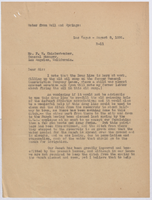Search the Special Collections and Archives Portal
Search Results

Letter from Walter R. Bracken (Las Vegas) to F. H. Knickerbocker (Los Angeles), regarding water from well and springs, August 8, 1934.
Date
Archival Collection
Description
Walter Bracken asking for permission to fill in the swimming pool and use the company drag line to clean out the ditch to the Las Vegas Ranch so overflow could be used by the lesee rather than go to waste.
Text

Photograph of mail carrier train, (Nev.), 1926-1940
Date
Archival Collection
Description
Image

Letter from G. T. Wickstrom (Omaha) to E. E. Bennett (Los Angeles), October 9, 1953
Date
Archival Collection
Description
The contract between the Las Vegas Land and Water Company and the Las Vegas Valley Water District said that all material and equipment used for business would go to the District. Wickstrom is requesting to know what to do with pipe belonging to the Union Pacific Railroad but intended for the Las Vegas Land and Water Co.
Text

Midway Ore Station at Tonopah and Tidewater: photograph
Date
Archival Collection
Description
Image
Marie Heher oral history interview
Identifier
Abstract
Oral history interview with Marie Heher conducted by her daughter Sharon Heher on March 01, 1977 for the Ralph Roske Oral History Project on Early Las Vegas. In the interview, Heher discusses her early life in Boulder City, Nevada and Henderson, Nevada, as well as her education in Reno, Nevada and Las Vegas, Nevada. Heher also discusses the Helldorado parades and her experiences with the Union Pacific Train Depot in downtown Las Vegas, Nevada.
Archival Collection
Union Pacific Railroad Photographs
Identifier
Abstract
The Union Pacific Railroad Photographs depict the Union Pacific Railroad Company's tracks, depots, locomotives, and stations in Southern Nevada and Southern California from 1904 to 1973. The photographs primarily depict Union Pacific officials in Las Vegas, Nevada, construction of Boulder City, Nevada and the Hoover (Boulder) Dam, hotels and casinos in Las Vegas, and the aftermath of flooding in 1938 that damaged Union Pacific tracks.
Archival Collection
Lincoln County Museum Photograph Collection
Identifier
Abstract
The Lincoln County Museum Photograph Collection contains photographs of towns, railroads, and mining operations in Lincoln County, Nevada from 1870 to 1953. The photographs primarily depict mines and railroads in Pioche, Caliente, Bullionville, and Panaca from 1900 to 1908 during part of Nevada’s mining boom. The photographs also depict Paiute workers, horse freight teams, geographical landmarks, and students in Lincoln County.
Archival Collection
Robert M. Tubb oral history interview
Identifier
Abstract
Oral history interview with Robert M. Tubb conducted by Robert B. Grzywacz on March 01, 1975 for the Ralph Roske Oral History Project on Early Las Vegas. In this interview, Tubb discusses moving to Nevada in 1907. He describes his early life and his father's career on the railroad, as well as the time he spent living in Ash Meadows Spring, Nevada and Death Valley. Tubb also goes into detail about his education and the growth of Las Vegas, Nevada.
Archival Collection
Guy Hamblin oral history interview
Identifier
Abstract
Oral history interview with Guy Hamblin conducted by Barry Merrell on February 22, 1975 for the Ralph Roske Oral History Project on Early Las Vegas. Hamblin discusses moving from different towns in Nevada before settling down in Southern Nevada, viewing the above-ground atomic bomb tests, early Fremont Street, and his work on the railroad. Hamblin also discusses the demographic and economic changes that he has seen in Las Vegas, Nevada.
Archival Collection
Fred O. Wharton oral history interview
Identifier
Abstract
Oral history interview with Fred O. Wharton conducted by William B. Stabler on March 10, 1976 for the Ralph Roske Oral History Project on Early Las Vegas. Wharton describes the United States Air Force base in Tonopah, Nevada that was used to train B-29 bomber pilots during World War II. He also describes mining in Tonopah and in the greater Nye County, Nevada area, including what kinds of metals they mined and the processes used to extract them. Lastly, Wharton discusses the history of the railroads in Nye County, living in rural Nevada, and how Tonopah has changed.
Archival Collection
